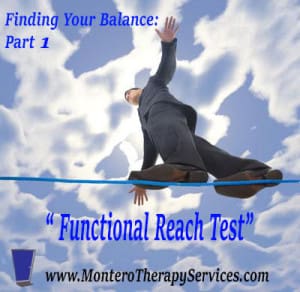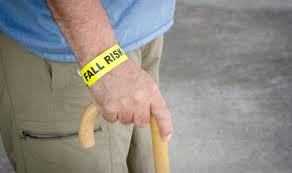As therapists working in the geriatric field, we are big on fall prevention. It’s what we do. We are often the ones educating others about fall prevention and safety measures…our residents, resident family members, the community, our facilities and other geriatric professionals. We have seen first-hand what falls can do to our residents, both physically and emotionally. Falls with or without injury carry a heavy quality of life impact associated with a fear of falling, and as a result, the start of the cycle of self-limiting activities, isolation and further physical decline. We, as therapists, can help break the cycle- isn’t that one of the reasons you love what you do?!?
fall prevention and safety measures…our residents, resident family members, the community, our facilities and other geriatric professionals. We have seen first-hand what falls can do to our residents, both physically and emotionally. Falls with or without injury carry a heavy quality of life impact associated with a fear of falling, and as a result, the start of the cycle of self-limiting activities, isolation and further physical decline. We, as therapists, can help break the cycle- isn’t that one of the reasons you love what you do?!?
While we don’t want any of our residents to fall, on the flipside, we don’t want to restrict mobility and independence either. Therapists in the long-term care setting are the clinicians providing recommendations to the nursing staff and care plan as to if a resident “can be independent or not” in the facility. This is a responsibility that should not be taken lightly – one that should be done based on objective tests and measures to support your clinical decision- whatever that decision ends up being. While no therapist wants to be responsible for “the fall that ended it all,” a clinical decision backed up by objective tests and measures will stand up to questioning much greater than basing decisions on “observations,” a “feeling,” or what other facility staff would like you to recommend.
Our goal over these next few weeks via this Blog, is to provide you with a series of clinically relevent objective tests and measures that you can use in your setting. For each of the tests reviewed here, we will give you:
- The “how to”
- The “pros and cons”
- The statistical measures
- The “norms” for the geriatric population
- A ready-to-use printout of a customized test form that you can use in your setting immediately (Available for subscribers of www.MonteroTherapyServices.com- Basic subscription in Free)
This objective data should be included in your clinical documentation and will support the necessity of your services and help support your goals and treatment plan. Not only that, but you will gain valuable insight into the specific limitations of your residents and be able to develop a natural progressive treatment plan to keep them on their feet! If you use an EMR, no worries, you can reference the test score in your electronic documentation and keep the paper copy in your soft chart. Remember, Medicare is looking for objective clinical data– so why not give it to them!!
But First, The Fall Facts…
Here are recent “fall facts” to have at your disposal. Tuck them away and pull them out when you need them.
According to the U.S. Centers for Disease Control and Prevention:
- One-third of Americans aged 65+ falls each year.
- Every 14 seconds, an older adult is treated in the emergency room for a fall; every 29 minutes, an older adult dies following a fall.
- Falls are the leading cause of fatal injury and the most common cause of nonfatal trauma-related hospital admissions among older adults.
- Falls result in more than 2.4 million injuries treated in emergency departments annually, including over 772,000 hospitalizations and more than 21,700 deaths.
- In 2012, the total cost of fall injuries was over $36 billion.
- The financial toll for older adult falls is expected to increase as the population ages and may reach $59.6 billion by 2020.
Measuring Balance
When selecting a test to measure balance, there are multiple factors therapists consider, which ultimately help match up a test to our resident.
- How practical is the test?
- Is the test easy to administer?
- Can the test be incorporated into a treatment session?
- Is it cost effective?
- Is equipment required?
- Statistically is it a “good” test — is it reliable, valid, reproducible?
For our geriatric residents, there are also multiple additional considerations including: cognition, medications and interactions, sensory impairments, endurance and the severity of the balance impairment we are attempting to measure… just to name a few.
The Functional Reach Test
What Does It Measure?: Functional balance by measuring the maximal distance one can reach forward while maintaining a flexed base of support in the standing position
How Long Does It Take?: Less than 5 minutes
Equipment Needed?: Yardstick, Tape/Velcro, 3 feet of wall space
How To:
- Resident stands along-side wall with arm closest to wall at 90 shoulder flexion with closed fist
- Record starting position of 3rd metacarpal head on the yardstick
- Instruct patient to “reach as far as you can without moving feet”
- Record location of 3rd metacarpal
- The difference between the start and end position is the reach distance. Record in inches.
- Perform 3 trials. The average of the last 2 is recorded.
Norms:
- 20-40 y.o. = 16.73 inches for men and 14.64 inches for women
- 41-69 y.o. = 14.98 in. men and 13.81 in. women
- 70-87 y.o. = 13.16 in. men and 10.47 in. women
Results:
- <6 inches = High Fall Risk
- 7-10 inches = Moderate Fall Risk
- >10 inches = Low Fall Risk
Pros: Quick, valid, reliable, minimal equipment and space
Cons: Only tests 1 plane of motion at a time, need to be able to follow directions, need adequate shoulder ROM
Print Out of Test and Documentation Form from the Toolbox
Documentation and Billing
The initial performance of the test can be incorporated into an initial evaluation or performed separately at any time during the course of treatment. If the test is performed on the initial evaluation, the score can be documented and used to establish short and long term goals for balance improvement, or “fall risk reduction.” Subsequent repeat performances of the test can be done during a treatment session and the time can be allocated to CPT 97112, neuro muscular re-education, a time-based code incorporating therapeutic procedures to improve balance, coordination, kinesthetic sense, posture, and proprioception. If you choose to use balance as a measure for your Functional Limitation Reporting, the G-Code Category “Changing and Maintaining Body Position” is appropriate, with G8981 for the Current Status, G8982 for the Goal Status and G8983 for the Discharge Status.
Treatment sessions can include portions of the test incorporated into treatment activities such as reaching in all planes with feet apart, feet together, feet semi-tandem and feet tandem, as a progression. Eyes open and closed can vary the difficulty, depending on the residents deficits.
In Summary
Residents like to see evidence that they are progressing, and even though they may not have progressed to the next “level” of independence, the Functional Reach Test allows them to see that they are reaching farther with less loss of balance, and that provides positive reinforcement to continue to progress toward goals. Though this test may not be among the most “popularly discussed” balance tests out there, the Functional Reach Test is truly one of the easiest tests to perform anywhere, anytime. This test also has modifications for performance in sitting and these test outcomes have had a significant correlation to the Balance Master measure of balance post stroke.
Whether you are screening residents for fall risk or providing treatment to residents with balance deficits, if you have not been using objective tests and measures for balance, the Functional Reach Test is a great place to start.
Now Test-Away!
Any questions, Just Ask! by visiting our Q&A forum.
In Your Corner,
Dolores
*A special thank you to physical therapist extraordinaire, Laura Minnick, for contributions to this post.
